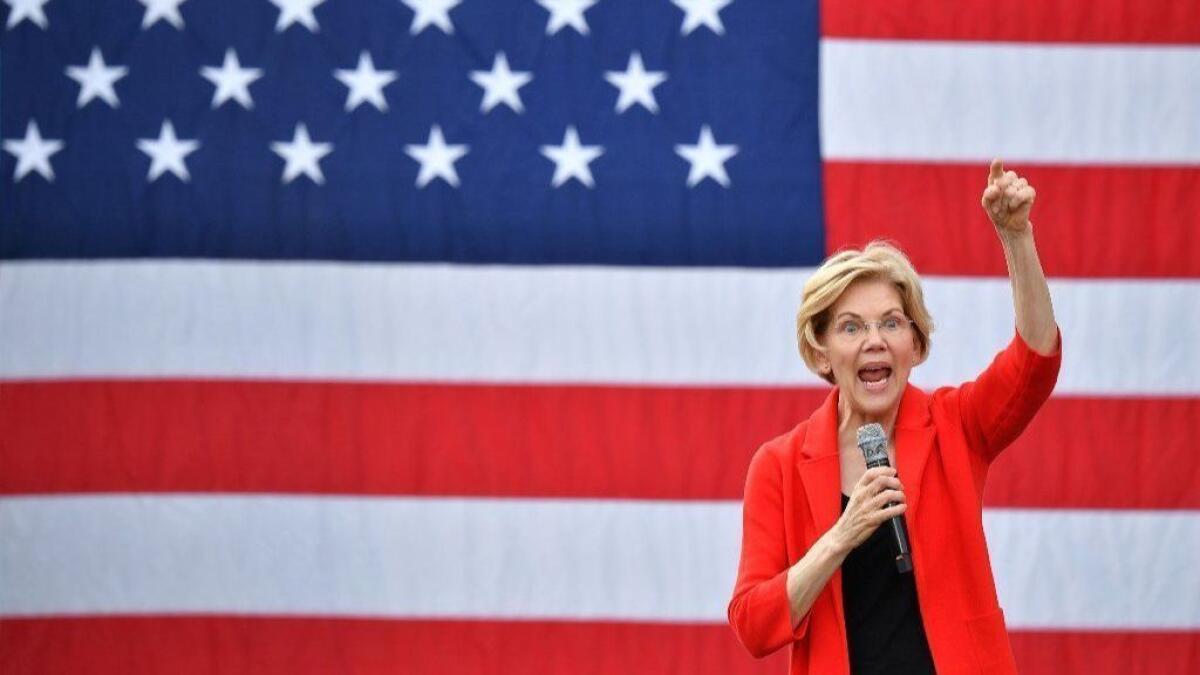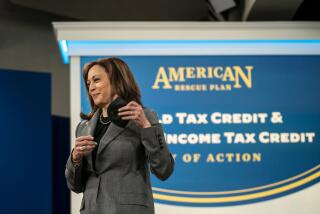‘How are you going to pay for it?’ — 2020 candidates wrestle with their costly plans

They keep piling up, sometimes trillions of dollars at a time.
The competition among 2020 Democratic presidential hopefuls to be bold in confronting vexing social and economic challenges has created a mountain of policy promises. The rising price tag has implications the contenders prefer to sidestep.
Candidates’ breezy assurances that everything from four years of college to first-class medical care to cash payments for the middle class can be had for free — unless you are one of those very wealthy Americans targeted to foot the bill — have concerned even liberal economists.
“These big, ambitious proposals are so expensive, it is not possible to pay for them by just taxing the rich,” said Howard Gleckman, a senior fellow at the Urban-Brookings Tax Policy Center. “They are going to require taxing middle income people…. But talking about that just doesn’t fly politically.”
Democrats have always favored big investment in government, but it’s been decades since so many in the primary field have pushed so much spending, with so little constraint. The fiscal abandon with which the GOP powered its huge tax cut package — running up the red ink by hundreds of billions of dollars — has moved Democrats to also aggressively test budget boundaries.
Revised thinking on the danger of deficits is giving them some cover. Economists who championed restraint in the Obama and Clinton White Houses now argue that the current economic climate of low interest rates, which shows signs of persisting, mitigates the danger of deficit spending.
“Politicians and policymakers should focus on urgent social problems, not deficits,” Jason Furman, who headed the Council of Economic Advisors in the Obama White House, and Lawrence Summers, the Clinton administration’s Treasury secretary, wrote in a recent piece for Foreign Affairs.
“Low interest rates are forcing a lot of people to reevaluate things,” Furman said in an interview.
The economic argument against big government deficits is that the need to borrow money to pay the bills will crowd out private investment, driving up interest rates and, ultimately, slowing economic growth. The fact that interest rates have remained persistently low despite rising deficits shows that’s not happening. High levels of government spending may be needed right now to keep the economy healthy, say Furman, Summers and their allies, including Olivier Blanchard, the former chief economist at the International Monetary Fund.
That case has been eagerly embraced by the Democratic presidential candidates.
Too eagerly for the economists, in fact, whose argument is filled with nuance that most of the 2020 hopefuls are choosing to overlook.
Neither Furman nor Summers has given anything close to a seal of approval to the way many of the top-tier candidates are framing what the nation can afford.
“It is one of these unfortunate things where the economists are writing with all kinds of caveats that are being ignored by the politicians,” said Alan Auerbach, chair of the economics department at UC Berkeley.
Promises to roll back the Trump tax cuts don’t come close to covering the bill. By the time the proposal for a many-trillion-dollar Green New Deal hit Congress, and most of the 2020 hopefuls scrambled to sign on, leading contenders were already drafting policies that eclipsed the cost of the tax law.
The additional levies on the wealthy and corporations that some candidates promote wouldn’t do the trick, either, Democratic economists agree.
“You can do a lot with those,” said Furman. “But not as much as people are promising.”
The detailed plan Massachusetts Sen. Elizabeth Warren offers to pay for her ambitious agenda provides a case in point. Warren makes her proposals to pay for her plan part of her pitch. She would leave the burden entirely on the rich — keeping with her vow to tap the corporate titans and family dynasties that she argues exploit a shrinking middle class.
“Can we talk about how to pay for it?” Warren enthusiastically said on a recent CNN town hall after rattling off her proposal for free college. Taxing the super-wealthy just 2 cents on every dollar they amass over $50 million would cover an astonishing government expansion, she said.
“We can do universal child care for every baby zero to 5, universal pre-K, universal college and knock back the student loan debt burden for 95% of our students and still have nearly a trillion dollars left over,” Warren said.
The reality is not so easy — and not just because of the long odds against passing any such wealth tax through Congress or the legal issues about whether such a tax would pass constitutional muster. Warren’s projections for what the wealth tax would generate are extremely optimistic. Twelve countries had such wealth taxes in 1990, and all but three have abandoned them because they didn’t create the windfall projected, as Summers, among others, has pointed out.
Countries that dropped their wealth taxes did so in part because of the difficulties involved in tracking down and valuing the assets of the super-wealthy — how much is that art collection worth? Who really owns that small, tropical island? — and in part because other forms of taxation proved more efficient in paying for social-welfare spending. Most European countries spend more on social programs than the U.S., but they also levy hefty consumption taxes that hit people at all income levels.
The candidate is undeterred. Earlier this month, Warren vowed more spending from the wealth tax: $100 billion to confront opioid abuse.
One of Warren’s opponents, California Sen. Kamala Harris, sometimes mocks those who chafe at the potential price tag for her big plans. After promising a refundable tax cut that would put $500 per month into the pockets of families earning less than $100,000 per year, Harris at one appearance earlier this spring shifted into her impersonation of a naysayer, projecting a nasally, know-it-all voice: “Well, how are you going to pay for it.”
The audience laughed. “I will tell you how,” Harris said. “On Day One, we are going to repeal that tax bill that benefited the top 1% and the biggest corporations of America. That’s how.”
A full repeal of the Trump tax cut could cover the cost of Harris’ tax plan, but only if provisions in the Trump tax bill that cut middle-class taxes were also scrapped. And Harris acknowledges separate tax hikes would be required to fund her other signature proposal, which would boost teacher pay nationwide an average of $13,500 a year, costing $315 billion over a decade.
And then there are the even bigger plans: the Green New Deal that most Democrats say they support could cost in the range of $1 trillion per year, depending on which version people espouse.
Medicare for all, which Sen. Bernie Sanders and some Democrats back, would increase government spending by as much as $30 trillion over a decade. Sanders and other backers say higher taxes would be offset by eliminating health insurance premiums. While that might be true for the economy as a whole — depending on how generous Medicare-for-all benefits would be — some individuals would definitely pay more.
Former Vice President Joe Biden has unveiled more modest plans so far, but they still involve hefty spending — which Biden, like the others, insists won’t cost anyone who isn’t very rich.
“We can do this all without punishing anybody,” Biden said during his campaign kickoff tour in Iowa. “By eliminating hundreds of billions of dollars in loopholes for the super-wealthy. And it is not going to, again, punish anybody.”
Sometimes the Democrats will argue the big-ticket spending will pay for itself by stimulating the economy. It’s a familiar argument to Gleckman, as it sounds much like the GOP’s trickle-down economics Democrats long reviled. Only the left’s aspiration is that enormous government spending — not enormous tax cuts — will pay for itself.
“The idea that you can spend with impunity, and it will pay for itself is as outrageous as saying you can cut taxes, and it will pay for itself,” he said. “For every government program that pays for itself, I can give you a bridge to nowhere and raise you an airplane that doesn’t fly.”
More to Read
Get the L.A. Times Politics newsletter
Deeply reported insights into legislation, politics and policy from Sacramento, Washington and beyond. In your inbox three times per week.
You may occasionally receive promotional content from the Los Angeles Times.











